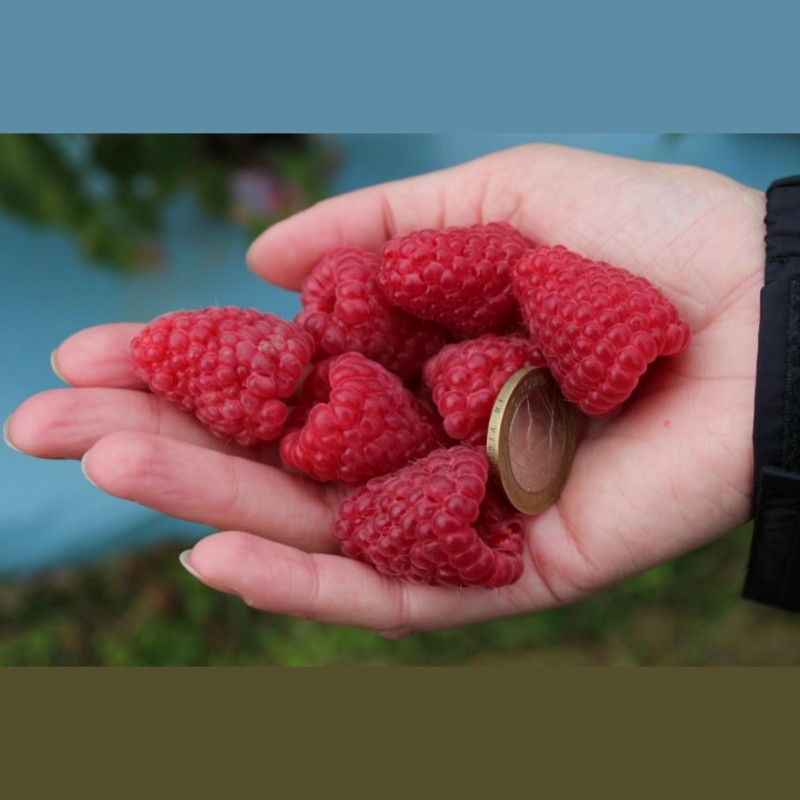
Planta gigante (con frutos gigantes)







La frambuesa (Rubus idaeus) es una especie de planta del género Rubus nativa de Europa y norte de Asia. Se trata de un arbusto perenne bienal de entre 1,5 y 2,5 m de altura. Crece con mayor frecuencia en claros de bosques o prados
espacio abierto para que medre esta colonizadora oportunista. Es de fácil cultivo y tiene tendencia a extenderse a menos que se la mantenga bajo control. Prefiere suelos profundos y ácidos, pues los calcáreos producen clorosis.
Su fruto es conocido con el mismo nombre que la planta y consiste en una polidrupa de sabor fuerte y dulce. La frambuesa fructifica a finales de verano o principios de otoño. Esta fruta del bosque es parecida a la zarzamora, pero más pequeña y blanda.
La frambuesa negra (Rubus occidentalis) y la frambuesa azul (Rubus leucodermis) son oriundas de América. En Asia (desde la India hasta China) existen alrededor de 180 tipos de frambuesas todavía no catalogados.
Actualmente existen dos cruces de R. idaeus con especies americanas R. occidentalis. De estos cruces se han obtenido diferentes variedades para mejorar la producción de fruto, que llega a las dos cosechas anuales (floración de primavera y estival).
La frambuesa amarilla se adapta fácilmente a zonas húmedas, creciendo generalmente en campos, zonas pantanosas y en bosques claros. Es consumida habitualmente en países escandinavos. Presenta tres variedades: goldie, amber y fallgold.
Principios activos
Entre otros nutrientes, sus frutas contienen cantidades considerables de ácido elágico, una sustancia que podría ser beneficiosa en la quimioprevención de ciertos tipos de cáncer. Las frambuesas oscuras (negras y azules) contienen cantidades considerables de antocianina –igual que el ácido elágico, un biofenol– que se aplica contra los radicales libres de oxígeno, los que provocan la degeneración de células y de los órganos en mamíferos. Estudios de la Ohio State University dirigidos por el profesor Gary Stoner llevaron a la presentación de una solicitud de patente en los Estados Unidos (USPTO), respecto de los usos del ácido elágico y la antocianina para combatir la degeneración de órganos y diferentes tipos de cáncer.
Nombre común
Los nombres comunes de la especie en castellano incluyen los siguientes: altimora, altimoras, antimora, artimora, artos, chardonera, chordón, chordonera, chordones, churdón, fragaria mayor, frambuesa, frambueso, morapeluda, moras terreras, moras terrestres, rubo ideo espinoso, rubo ideo fructífero, rubo ideo infructífero, ruo ideo no espinoso, sangüesa, sangüesa blanca, sangüesa real, sangüesa silvestre, sangüeso, uvas de oso, yrdús, zarza idea, zarza llamada idea, zarza sin espinas.
Fill a seed starter tray with sterile potting soil in the early fall. Press one to two raspberry seeds ¼ inch down into the soil of each cell. Pat the soil down gently over the seeds to remove air pockets.
Mist the soil lightly to dampen, using a spray bottle filled with water. Keep the soil moist throughout the germination process. Place the seed starter tray in a cool, dark area while the raspberry seeds germinate. The seeds will begin to sprout within three months.
Set the seed starter tray in an area that receives bright, indirect sunlight once the seeds begin to sprout. If this is not possible, set up a grow light and place the seed starter tray underneath.
Continue to keep the soil moist and provide the raspberry plants with adequate light as they continue to grow. Transplant the raspberry plants outdoors in the spring, as soon as the soil is workable.
Select an area for transplanting your raspberries that contains full sun and well-drained soil with a pH between 5.5 and 6.5. Test the soil if you are unsure of your soil pH, using a soil testing kit purchased from a garden center.
Turn over the soil with a pitchfork after the final winter frost and add lime to the soil if the pH is below 5.5. Add peat moss if the soil pH is above 6.5. Add the required amendment according to label instructions.
Dig holes for the raspberry plants that are comparable in size to their root balls. Space each hole 2 feet apart. Space rows 8 to 12 feet apart. Remove the raspberry plants from the seed starter tray, placing one raspberry plant in the center of each hole. Backfill the holes.
Water the raspberry plants generously after planting. Use a soaker hose that will deliver deep watering. Water at a rate of 1 inch per week, keeping the soil moist at all times during the growing season.
Cut the raspberry plants down to the soil line, using a sharp pair of scissors or pruning shears, in the late fall. Cutting the plants back will encourage growth the following spring.
Fertilize the raspberry plants the following spring when they begin to grow again. Apply a 10-10-10 fertilizer per label instructions. Continue to keep the soil moist. Harvest the raspberries when they ripen in the summer.
Ficha técnica